For 16 years now, Architecture & Design magazine has hosted the nation’s most respected and most coveted Sustainability Awards program that is devoted entirely to Australia’s vibrant and vital building, construction, and design sectors.
The Architecture & Design Sustainability Awards are one of the rare national industry programs that bring leading designers, suppliers, and sustainable building practitioners all together in one place to celebrate the industry’s best projects, products, and of course, people that this country has to offer.
In order to be able to deliver such a distinguished level of award, we rely on the highest calibre and most diverse set of entries to ensure that all our finalists (and, of course the ultimate winners) of each category represent, quite simply, Australia’s best and brightest from our built environment.
These 16th consecutive Sustainability Awards will be run along with the Sustainability Summit program both as both a live event in the luxury Shangri-La Sydney on November 10 and also, online for our increasingly important global audience.
So to ensure the ongoing success of the Sustainability Awards, we must have the very best entries that our industry has to offer, so as to help make the 2021 Architecture & Design Sustainability Awards the best yet.
Over the previous years, we have had a range of exciting, diverse, and stunning entries that have shown just how far the issue of sustainability has come in Australia.
Below are some of the judges’ favourite Sustainability Awards past winning entries, with the common themes of dedication and unwavering support for sustainable goals.
If you think that you can match these past winners with your entry, you need to enter the 2022 Sustainability Awards.
The 2021 winners were:
Adaptive Reuse (Alteration / Addition)
Recognises the adaptive reuse of a building (heritage and/or new) that has minimal impact on the historical significance of the building and its setting, while also pursuing a design that is sympathetic to the building in order to give it a new purpose.
Proudly partnered by Havwoods International
Winner: Smart Design Studio by Smart Design Studio
Completed in December 2019, Smart Design Studio comprises the adaptive reuse of a Post-War single storey industrial warehouse, into commercial and residential uses across a 3624 sqm site. The project is situated within the North Alexandria Industrial Heritage Conservation Area, which forms part of one of the largest known collections of industrial and warehouse buildings of its kind in Australia.
The retention and adaptation of the existing building was therefore the springboard for this innovative project. Most of the original building fabric was retained and restored, including brick facades, sawtooth roofs and steel roof trusses. The key innovation was to transform an existing warehouse into a carbon neutral building, targeting a six-star NABERS energy rating.
Photo: Romello Pereira & David Hutton.
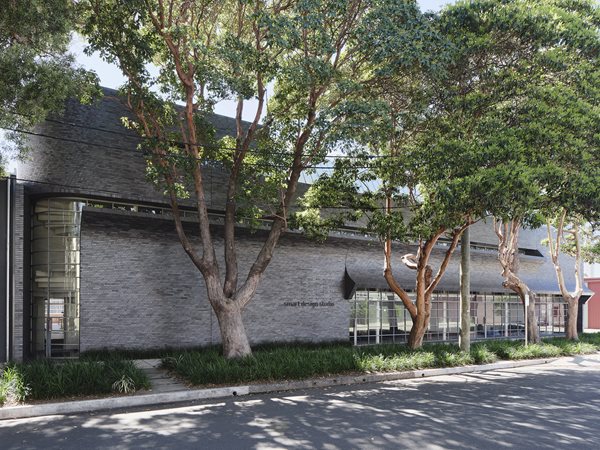
Highly Commended: Goodman Headquarters – The Hayesbery (Intermain with Woods Bagot)
+Olderfleet (Mirvac)
Commercial Architecture (Large)
A Class 5, 6, 7 or 8 building used for professional and / or commercial purposes of over 500sqm in floor size.
Proudly partnered by Interface
Winner: Olderfleet (Mirvac)
The 58,000sqm building uniquely integrates a modern 38-level commercial tower, drawing together premium-grade office and retail space, with one of Melbourne’s most important pieces of heritage architecture, the Olderfleet buildings.
The workplace incorporates a 30-metre-high lobby with a unique art installation and a range of on-site services, from a wellness centre and luxurious hotel-style end-of-trip facilities to a childcare centre and an underground bar. It was the first building in Australia to achieve a Platinum Core and Shell Pre-Certification from the International WELL Building Institute, which recognises excellence in delivering healthy buildings and improving tenant wellbeing in a sustainable work environment. Olderfleet also targets a 6 Star Green Star rating, 5 NABERS Energy rating, and 4 Star NABERS Water rating.
Photography: John Gollings
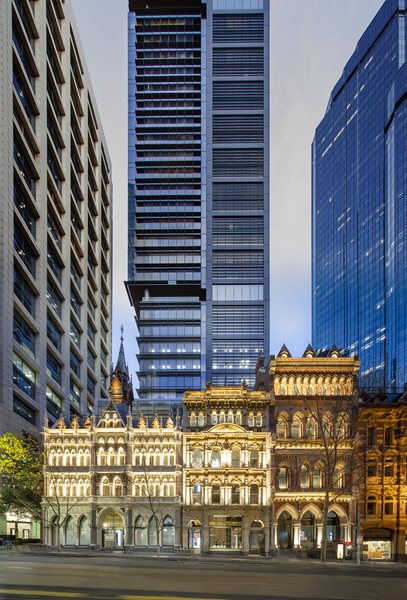
Commercial Architecture (Small)
A Class 5, 6, 7 or 8 building used for professional and / or commercial purposes of under or equal to 500sqm in floor size.
Proudly partnered by Autex Acoustics
Winner: Ona Coffee Melbourne (Breathe Architecture)
Sustainability was always a priority for Ona, not an afterthought. Sustainability features include being 100% electric, induction cooktops, 20kW of solar on the re-insulated roof with remaining energy requirements provided by 100% Green Power.
A rigorous carbon audit was undertaken to offset any greenhouse gas emissions. 5000 litre rain water tanks, organics waste streams, natural light and ample bike parking were incorporated into the design. Rather than space for cars, a multilevel amphitheatre, that in time will be run wild with greenery, was built by locals and for locals. Sun-drenched but shaded by natives, this built space is for coffee drinkers, food lovers, dogs, kids, prams, wheelchairs.
Photo: Tom Ross
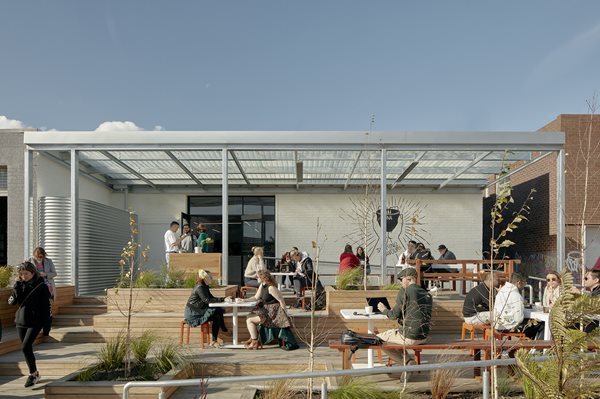
Highly Commended: Rosby Cellar Door and Gallery (Cameron Anderson Architects)
+
Gurriny Yealamucka Health and Wellbeing Centre POD (People Oriented Design)
Education & Research
A childcare centre, preschool, primary, secondary or tertiary educational facility or a facility where an educational institution is a partner.
Proudly partnered by Alspec
Winner: Ainsworth Building, Faculty of Medicine and Health Sciences, Macquarie University (Architectus)
Mass timber accounts for 95 percent (by weight) of the timber material used in the Ainsworth Building. Although mostly sourced from Europe, the ecological impact remains low due to the contribution of clean energy towards producing the mass timbers in Austria. 100 percent of the mass timber used in the Ainsworth Building is Programme for the Endorsement of
Photo: Brent Boardman Photography, Red Square Media
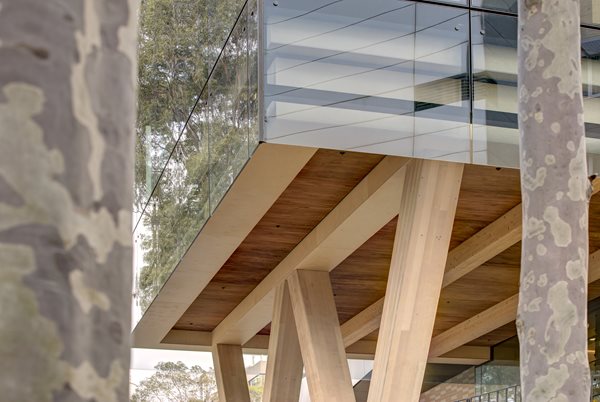
Highly Commended: La Trobe University Sports Park (Warren and Mahoney)
Emerging Sustainable Architect / Designer
Open to architects / designers in their first five years of their career and recognises an outstanding achievement or development in the field of sustainable and / or environmental architecture planning or design across any of the building categories.
Proudly partnered by Cosentino
Winner: David Coates (Sustainable Building & Design)
David is living proof & a fantastic example of a complete success in being able to achieve a sustainable home with a negative carbon footprint. Graduating from the school of life, gaining real life experiences from living & working in other countries abroad gaining a global concept for sustainable design, he has brought to Australia a very positive gift with his enthusiasm & proactive approach to making a real change.
His journey began as a 16-year-old apprentice carpenter & has more recently within the past 5 years resulted as a cutting-edge sustainable designer. Over recent years, David has shown Melbourne his innovative renewable energy creations, that are not only 'sustainable,' in every sense of the word, attracting quite a lot of attention amongst the growing sustainably minded community, they are also extremely functional & aesthetically eye catching, with a ‘wow’ factor of originality.
Photo: Amelia Batchelor
Green Building Material
A building product that is renewable, environmentally responsible and where the impact is considered over the entire lifetime of the product.
Proudly partnered by Big Ass Fans
Winner: ECOPact and ECOPact Zero (Holcim)
Launched in April this year, ECOPact is lower carbon concrete developed by Holcim Australia. With ECOPact, the carbon intensity can be reduced by 30-60% by replacing the standard cement with alternative alternative materials. These include industrial by-products like fly ash, blast furnace slag or silica fume. ECOPact provides designers and contractors with easy solutions to achieve lower embodied carbon outcomes in their projects.
ECOPact is produced with significantly less cement making production more sustainable than standard concrete.
ECOPact is eligible for Green Star and Infrastructure Sustainability rating criteria.
Photo: Mosaic

Highly Commended: Compostable Insulation - Mycelium Biomaterials in Architecture
(Micoeden)
+
SMaRT apartment at Pavilions Residences (Mirvac)
Lifetime Achievement
A person who has over their career, shown exemplary efforts in advancing the progression of the sustainable built environment in Australia.
Proudly partnered by BlueScope
Winner: Tone Wheeler (environa)
Tone has played a very public role in promoting architecture in Australia for five decades, starting from his student days in the 1970s and throughout his long career. Tone founded environa studio in 1986, and through that practice’s output has consistently demonstrated leadership around sustainability since before it became a fashionable buzz word. In recent years, he’s focussed on progressing sustainability ideals on larger-scale projects, and for projects for clients and end-users who don’t always enjoy the many benefits of good design.
As well as designing and delivering private homes, environa has delivered project homes, retirement communities, a major sustainability overhaul of Kings Cross’ beloved Wayside Chapel (pro bono), new boarding houses, multi-res apartment developments and industrial buildings.
Tone strives to make architecture and sustainability accessible and approachable for a broad audience. And through his efforts, he has inspired progress and supported clients, collaborators, and the general public to invest in and place value on the creation of built environments that elevate social and environmental aspirations (alongside the financial concerns that underpin all projects).

Multi-Residential Dwelling
The design of a new townhouse, duplex or residential complex that contains multiple residential dwellings. Projects nominated under this category are classifiable as Class 2 or Class 3 buildings.
Winner: Breese St by Milieu (DKO Architecture, Breathe Architecture and Milieu Property)
Proudly partnered by Electrolux
Designed as a collaboration between DKO Architecture, Breathe Architecture and Milieu Property, Breese St was informed through careful study of the requirements of urban living anchored in nurturing community and championing sustainability. The architecture fits the narrative of Brunswick’s industrial heritage of the past while leading to a sustainable future. The design team prioritised ethics over aesthetics. Smaller footprints, less applied finishes, more robust materials and more efficient construction. Aiming to build less and give more. Careful attention is paid to the lifecycle of each material used.
Designed with material sustainability at the forefront, materials are recycled, recyclable, low carbon and locally sourced where possible. Breese Street’s residents will form a genuine community, one where neighbours connect – not over the fence in this instance, but while tending gardens on the rooftop. This ‘backyard in the sky’ includes native plants, beehives and a community vegetable plot intended to support a natural ecosystem which attracts wildlife.
Barbeque, outdoor dining areas and communal workspaces again encourage chance encounters and social interactions. The rooftop also includes a shared laundry and clothesline to reduce energy and water usage. A 20,000-litre tank collects rainwater to be redirected to garden irrigation, while a compost area will minimise food waste and contribute to the garden.
Photo: Tom Ross
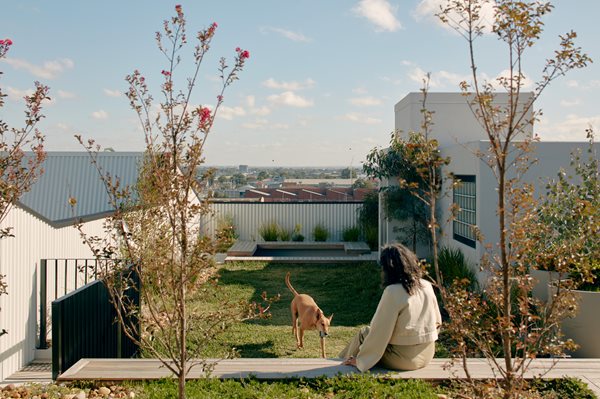
Highly Commended: La Trobe University North and South Apartments (Jackson Clements Burrows Architects with Stantec)
Public, Urban & Landscape
A building or facility or artwork which primarily services, or is used by the public except educational facilities.
Proudly partnered by Rocks On
Winner: People Parkers (Alexander Symes Architect)
The People Parkers recycled plastic mobile parklet facilitates the rapid, sustainable and considered reimagining of car parking spaces and roadways into temporary outdoor dining quarters. In 2015 People Parkers was born out of Glebe Point Road Trial Parklet Program which was a case study of how parklets could be used to improve amenity, community and business outcomes along Glebe point road.
Most parklets are custom and hence expensive or not robust for longevity, are not easily moved to multiple sites and hence the main aim of a tactical intervention is achieved short term, but the total sustainability question is not answered. Hence people parkers started developing a suite of movable, robust, re-usable, designed for disassembly parklet design that were recyclable and made from low environmental impact materials where possible.
The aim was to provide a suite of products that could be employed anywhere to demonstrate how a street could be more than a place to park a vehicle which is and will be an essential question as we progress to car-share and shared autonomous vehicles in the future.
Photo: Barton Taylor & David Li.
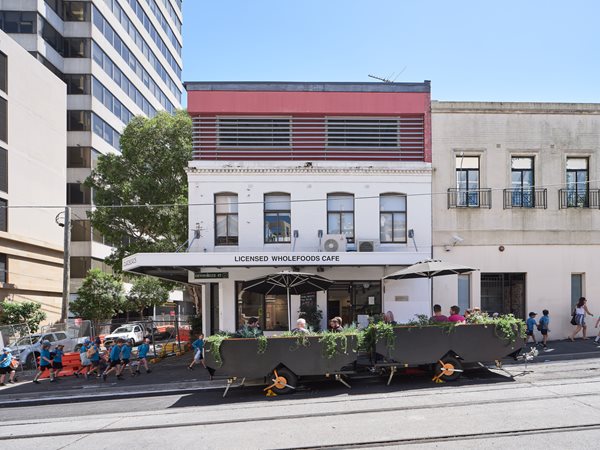
Highly Commended: Gunyama Park Aquatic and Recreation Centre (Andrew Burges Architects and Grimshaw in collaboration with the City of Sydney)
Single Dwelling (Alteration / Addition)
Extensions and/or alterations to at least 50 percent of a Class 1a building.
Proudly partnered by Stormtech
Winner: Light House (Alexander Symes Architect)
Light house is an example of how a typical poorly designed dwelling that does not perform well thermally, from a daylight perspective or how it integrates with landscape can be converted to address each well whilst retaining the majority of the existing structure. The project is called Light House as it:
- Create a well and evenly distributed day LIGHT home as the existing dwelling was poor on both fronts.
- LIGHT on embodied energy through conserving as much of the existing as functionally possible and using low embodied energy for all new construction.
- LIGHT on operational energy via high efficiency envelope and high efficiency appliances and onsite renewables. PV / Heat Pumps running of solar only for pool heating / Sanden DWU / EV charging
- LIGHT on biodiversity via increasing porosity onsite and planting endemic garden. The dwelling creates a connection to nature with all windows framing a view of landscape and creating a sense that you are not actually in quite a dense urban area.
Photo: Barton Taylor
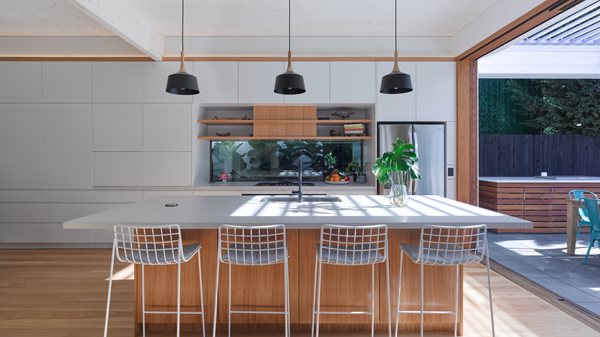
Highly Commended: Little Loft House (Light House Architecture and Science)
+
Chelmer Flood House (JDA Co.)
Single Dwelling (New)
The design and construction of a single-residential building to which a Class 1a Building category.
Proudly partnered by Wattyl
Winner: Urban Green Home Build (Sustainable Building & Design)
An 8.4 star NatHERS energy efficient rating, sustainable home completed in July 2020. The Project has been to design and build a 2-bedroom, 2-bathroom, single storey urban dwelling. This light filled contemporary home, showcases what is possible when sustainability is embedded in the design DNA. The owners wanted to create a comfortable, healthy & attractive home with a small carbon footprint & low maintenance requirements. They have been fortunate to work with our company Sustainable Building & Design (SBAD), as we have a similar passion for sustainable living along with the skills & experience to have been able to bring this project to life. Building sustainable homes is imperative if Australian cities are going to meet UN Sustainability Goal 11 (Sustainable Cities and Communities).
The potential benefits from low energy urban dwellings are significant with cities currently accounting for up to 80% of worldwide energy consumption and 70% of human-induced greenhouse gas emissions. At the core of this project was the desire to innovate, to showcase a revolution in sustainable building practices, not simply make minor improvements based on an evolution of standard practices.
Photo: Matthew Mallett
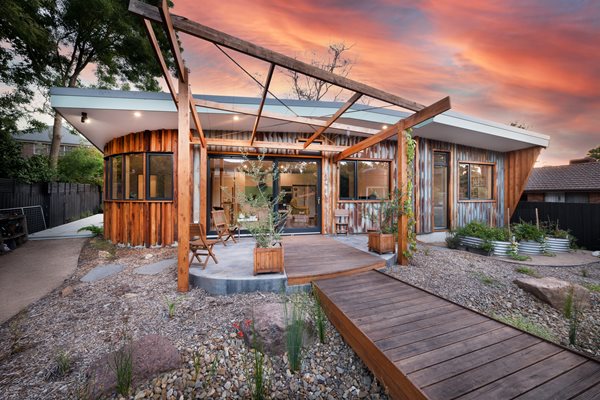
Highly Commended: LiveWorkShare House (Bligh Graham Architects)
+
Off Grid FZ House (Anderson Architecture)
Smart Building Ideas
A building that uses smart design or a range of automated processes to automatically control the building’s operations in order to help improve asset reliability, performance, and energy use.
Proudly partnered by ASP Access Floors International
Winner: Urban Green Home Build (Sustainable Building & Design)
23 Alexandra Road is a community of three 2-bedroom, 2-bathroom, single storey homes, each one to be light-filled, comfortable and with a small carbon footprint.
An 8.4-star NatHERS energy efficient rating, sustainable home completed in July 2020. The overall development has been to design and build 3 2-bedroom, 2-bathroom, single storey urban dwellings. These light filled contemporary homes, showcase what is possible when sustainability is embedded in the design DNA. The owners wanted to create comfortable, healthy & attractive homes with a small carbon footprint & low maintenance requirements.
Photo: Dylan James
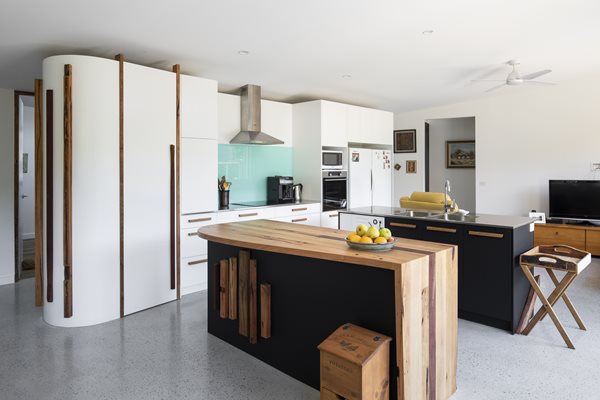
Women In Sustainability
Presented to a woman who has made a significant contribution to the built environment sustainability in Australia over the past 5 years.
Proudly partnered by Siniat
Winner: Belinda Allwood & Dr Shaneen Fantin (POD - People Oriented Design)
Belinda and Shaneen are extraordinary women architects and scholars who are committed to raising and promoting sustainability issues and outcomes in every project they undertake. It is embedded in the values of the business, People Oriented Design (created in 2014) and in their processes and systems. They champion sustainability from a holistic perspective which includes social, cultural, environmental and economic pillars. Their unique lens is informed by decades of work with First Nations people, growing up in farming families, and a deep respect for people, Country and Australian landscape.
Shaneen and Belinda have spent the last decade refining their intercultural design methodology which embeds Indigenous social and cultural sustainability into projects from the very beginning. As a result of this, they have been the design leaders on several innovative First Nations projects, particularly in the areas of health and housing.
Photo BlueClick Photography
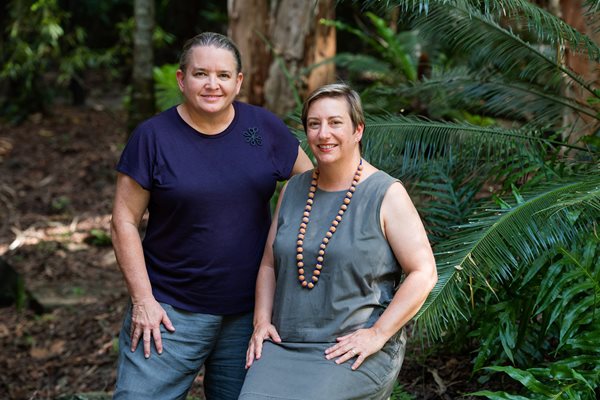
Best of the Best
Selected from among all the category winners on the basis of both sustainable outcomes and aesthetics and/or innovative design principles.
Proudly partnered by Alspec
Winner: ECOPact and ECOPact Zero (Holcim)
Launched in April this year, ECOPact is lower carbon concrete developed by Holcim Australia. With ECOPact, the carbon intensity can be reduced by 30-60% by replacing the standard cement with alternative alternative materials. These include industrial by-products like fly ash, blast furnace slag or silica fume.
ECOPact provides designers and contractors with easy solutions to achieve lower embodied carbon outcomes in their projects.
ECOPact is produced with significantly less cement making production more sustainable than standard concrete.
ECOPact is eligible for Green Star and Infrastructure Sustainability rating criteria.
Photo: Mosaic

If you think that your project is as good as any of these, then you need to enter the 2022 Sustainability Awards.
For more information or to enter, please click here.

